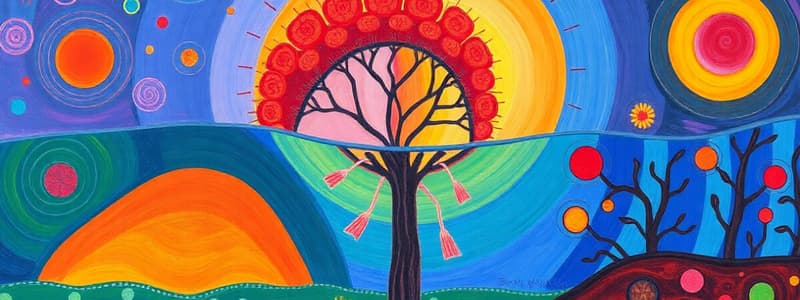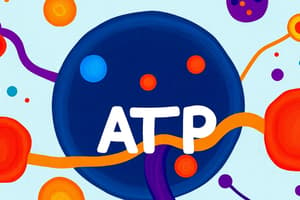Podcast
Questions and Answers
In cellular metabolism, how does fermentation differ fundamentally from respiration?
In cellular metabolism, how does fermentation differ fundamentally from respiration?
- Respiration occurs in the absence of oxygen; fermentation requires it.
- Fermentation utilizes mitochondria, while respiration occurs in the cytoplasm.
- Fermentation produces water as a by-product, unlike respiration.
- Respiration completely oxidizes food, whereas fermentation involves a partial breakdown of organic substrates. (correct)
Which statement accurately compares ATP production in fermentation versus respiration?
Which statement accurately compares ATP production in fermentation versus respiration?
- Fermentation produces 36 ATP molecules, while respiration generates only 2 ATP molecules.
- Fermentation yields a significantly lower number of ATP molecules compared to respiration. (correct)
- Both processes yield the same amount of ATP.
- Respiration produces 2 ATP molecules while fermentation produces 36 ATP molecules.
What role does oxygen play in respiration and fermentation processes?
What role does oxygen play in respiration and fermentation processes?
- Both respiration and fermentation require oxygen to proceed.
- Respiration requires oxygen as the final electron acceptor, while fermentation occurs in the absence of oxygen. (correct)
- Oxygen is the final electron acceptor in fermentation.
- Oxygen is the primary electron donor in both respiration and fermentation.
In an ecosystem, what proportion of energy available at one trophic level is typically transferred to the next level?
In an ecosystem, what proportion of energy available at one trophic level is typically transferred to the next level?
Which of the following trophic levels obtains energy directly from the sun?
Which of the following trophic levels obtains energy directly from the sun?
How does Saccharomyces cerevisiae (yeast) demonstrate a preference for fermentation even when oxygen is available?
How does Saccharomyces cerevisiae (yeast) demonstrate a preference for fermentation even when oxygen is available?
What is the role of decomposers in a food chain?
What is the role of decomposers in a food chain?
How do food chains and food webs differ in representing ecosystem interactions?
How do food chains and food webs differ in representing ecosystem interactions?
In an ecosystem, what distinguishes primary consumers from secondary consumers?
In an ecosystem, what distinguishes primary consumers from secondary consumers?
Which of the following best describes the flow of energy in a food web?
Which of the following best describes the flow of energy in a food web?
A population of rabbits is introduced to a new ecosystem with plentiful vegetation and no predators. Initially, the rabbit population grows rapidly. Which concept does this scenario exemplify?
A population of rabbits is introduced to a new ecosystem with plentiful vegetation and no predators. Initially, the rabbit population grows rapidly. Which concept does this scenario exemplify?
Which of the following organisms would occupy the first trophic level in a food web?
Which of the following organisms would occupy the first trophic level in a food web?
A lichen is a combination of algae and fungi, where the algae provides food for the fungi and the fungi provides a habitat for the algae. What type of symbiotic relationship is this?
A lichen is a combination of algae and fungi, where the algae provides food for the fungi and the fungi provides a habitat for the algae. What type of symbiotic relationship is this?
Consider a grassland ecosystem. If the grasshoppers (primary consumers) consume 5000 kcal of energy from the grass (producers), approximately how much energy would be available to the snakes (secondary consumers) that prey on the grasshoppers, assuming a typical ecological efficiency?
Consider a grassland ecosystem. If the grasshoppers (primary consumers) consume 5000 kcal of energy from the grass (producers), approximately how much energy would be available to the snakes (secondary consumers) that prey on the grasshoppers, assuming a typical ecological efficiency?
If the producer level in an ecosystem has 10,000 kcal of energy, approximately how much energy is available to the tertiary consumers?
If the producer level in an ecosystem has 10,000 kcal of energy, approximately how much energy is available to the tertiary consumers?
An orchid grows on a tree branch, benefiting from increased sunlight exposure, without affecting the tree. What type of symbiotic relationship is this?
An orchid grows on a tree branch, benefiting from increased sunlight exposure, without affecting the tree. What type of symbiotic relationship is this?
What is the primary role of photosynthetic producers in an ecosystem?
What is the primary role of photosynthetic producers in an ecosystem?
What factors determine the carrying capacity of a species in an ecosystem?
What factors determine the carrying capacity of a species in an ecosystem?
Which of the following cellular structures is primarily responsible for housing the cell's genetic material, akin to a library storing information?
Which of the following cellular structures is primarily responsible for housing the cell's genetic material, akin to a library storing information?
Consider a newly discovered organism. What minimum set of characteristics must it exhibit to be classified as a living thing according to the criteria described?
Consider a newly discovered organism. What minimum set of characteristics must it exhibit to be classified as a living thing according to the criteria described?
How does modern cell theory refine classical cell theory's understanding of cell origins?
How does modern cell theory refine classical cell theory's understanding of cell origins?
Which of the following best describes the relationship between cells, organs, and organ systems in multicellular organisms?
Which of the following best describes the relationship between cells, organs, and organ systems in multicellular organisms?
A scientist is studying a sample containing cells without a defined nucleus. Based on cell theory, which type of cell is the scientist most likely observing?
A scientist is studying a sample containing cells without a defined nucleus. Based on cell theory, which type of cell is the scientist most likely observing?
Which of the following scenarios best illustrates coevolution?
Which of the following scenarios best illustrates coevolution?
A harmless beetle species evolves to resemble a poisonous ladybug. This is an example of what?
A harmless beetle species evolves to resemble a poisonous ladybug. This is an example of what?
Which of the following human activities does NOT directly contribute to habitat alteration and loss of biodiversity?
Which of the following human activities does NOT directly contribute to habitat alteration and loss of biodiversity?
How does deforestation exacerbate climate change?
How does deforestation exacerbate climate change?
Which of the following is the most likely consequence of introducing a highly invasive plant species into a new ecosystem?
Which of the following is the most likely consequence of introducing a highly invasive plant species into a new ecosystem?
A remote island ecosystem has 500 species. If the background extinction rate is 1 species per million per year, how many extinctions would be expected on the island in 100 years, assuming only natural extinction causes?
A remote island ecosystem has 500 species. If the background extinction rate is 1 species per million per year, how many extinctions would be expected on the island in 100 years, assuming only natural extinction causes?
What is the primary difference between background extinction and mass extinction?
What is the primary difference between background extinction and mass extinction?
Which interaction is an example of parasitism?
Which interaction is an example of parasitism?
A population of brightly colored frogs are poisonous. A different population of brightly colored frogs are not poisonous, but resemble the poisonous ones. Are they both using Mullerian mimicry?
A population of brightly colored frogs are poisonous. A different population of brightly colored frogs are not poisonous, but resemble the poisonous ones. Are they both using Mullerian mimicry?
A lichen is a combination of fungi and algae, where the fungi protects the algae and the algae provides food for the fungi. Which type of symbiosis is this?
A lichen is a combination of fungi and algae, where the fungi protects the algae and the algae provides food for the fungi. Which type of symbiosis is this?
Flashcards
Trophic Levels
Trophic Levels
Sequential levels of energy transfer in an ecosystem.
Energy Pyramid
Energy Pyramid
A diagram showing energy flow and quantification across trophic levels.
Producers
Producers
Organisms that create their own food using sunlight (autotrophs).
Photosynthetic Producers
Photosynthetic Producers
Signup and view all the flashcards
Ten Percent Rule
Ten Percent Rule
Signup and view all the flashcards
Biotic Potential
Biotic Potential
Signup and view all the flashcards
Carrying Capacity
Carrying Capacity
Signup and view all the flashcards
Symbiosis
Symbiosis
Signup and view all the flashcards
Mutualism
Mutualism
Signup and view all the flashcards
Ectosymbiosis
Ectosymbiosis
Signup and view all the flashcards
Fermentation
Fermentation
Signup and view all the flashcards
Respiration
Respiration
Signup and view all the flashcards
ATP synthesis in Fermentation
ATP synthesis in Fermentation
Signup and view all the flashcards
ATP synthesis in Respiration
ATP synthesis in Respiration
Signup and view all the flashcards
Types of Fermentation
Types of Fermentation
Signup and view all the flashcards
Final electron acceptor in Fermentation vs Respiration
Final electron acceptor in Fermentation vs Respiration
Signup and view all the flashcards
Food Chains vs Food Webs
Food Chains vs Food Webs
Signup and view all the flashcards
Parasitism
Parasitism
Signup and view all the flashcards
Predation
Predation
Signup and view all the flashcards
Coevolution
Coevolution
Signup and view all the flashcards
Camouflage
Camouflage
Signup and view all the flashcards
Batesian mimicry
Batesian mimicry
Signup and view all the flashcards
Invasive species
Invasive species
Signup and view all the flashcards
Mass extinction
Mass extinction
Signup and view all the flashcards
Characteristics of Life
Characteristics of Life
Signup and view all the flashcards
Levels of Biological Organization
Levels of Biological Organization
Signup and view all the flashcards
Cell Theory
Cell Theory
Signup and view all the flashcards
Eukaryotic vs Prokaryotic Cells
Eukaryotic vs Prokaryotic Cells
Signup and view all the flashcards
Modern Cell Theory
Modern Cell Theory
Signup and view all the flashcards
Study Notes
Fermentation vs. Respiration
- Fermentation is the chemical breakdown of organic substrates by microorganisms, producing heat and effervescence. Respiration is a set of chemical reactions for complete food oxidation, producing energy.
- Fermentation occurs without oxygen, while respiration requires oxygen.
- Fermentation does not produce water as a byproduct, whereas respiration does.
- Fermentation happens in the cytoplasm. Respiration takes place in the mitochondria and cytoplasm.
- Fermentation synthesizes 2 ATP, while respiration produces 36 ATP molecules.
- Types of fermentation include ethanol and lactic acid fermentation. Respiration includes aerobic and anaerobic forms.
- The final electron acceptor in fermentation is an organic molecule; in respiration, it's primarily oxygen.
- Fermentation is common in microorganisms; respiration occurs in higher organisms.
Food Chains and Food Webs
- Food chains and food webs illustrate energy flow and organism interactions in ecosystems.
- Food chains show a single energy pathway between organisms.
- Food webs show the complex interconnectedness of multiple food chains.
- Producers (e.g., plants) form the base (first trophic level).
- Herbivores/primary consumers eat producers.
- Carnivores/omnivores (secondary, tertiary, or quaternary consumers) eat other consumers.
- Energy flows from producers to higher trophic levels in a food web or chain.
- About 10% of energy is transferred between trophic levels; the rest is lost as heat or used for metabolism.
Energy Pyramids
- Energy pyramids show the energy transfer in an ecosystem based on trophic levels.
- Producers receive 100% of the solar energy.
- Primary consumers receive 10% of the energy from producers.
- Secondary consumers receive 1% of the original solar energy.
- Tertiary consumers receive 0.1% of the initial solar energy.
- Energy loss occurs at each level.
The Sun as an Energy Source
- The sun is the Earth's primary energy source.
- Photosynthetic producers convert light energy into chemical energy (glucose).
- Consumers obtain energy by consuming producers.
- The sun's immense heat and pressure drive nuclear fusion, releasing energy.
Food Chains and Trophic Levels
- Food chains are the natural energy flow from one organism to another through eating or being eaten.
- Producers (autotrophs) are at the base, making their own food from sunlight.
- Consumers (heterotrophs) eat plants or animals to gain energy.
- Herbivores eat plants.
- Carnivores eat animals.
- Omnivores eat both plants and animals.
- Decomposers break down dead matter; detritus feeders (worms) and scavengers (buzzards) are types.
- Only 10% of energy is passed between levels.
Biotic Potential and Carrying Capacity
- Biotic potential is the maximum reproductive rate under ideal conditions.
- Carrying capacity is the maximum population size an environment can sustain.
- Environmental resistance limits population growth due to factors like disease, predators, and competition.
- Populations exceeding carrying capacity face resource scarcity.
Symbiosis
- Symbiosis describes relationships between different organisms, where at least one benefits.
- Mutualism: Both organisms benefit.
- Commensalism: One benefits, the other is unaffected.
- Parasitism: One benefits, the other is harmed.
- Ectosymbiosis: Organisms live on another organism.
- Endosymbiosis: Smaller organisms live inside another.
Predation and Coevolution
- Predation is when one organism hunts and eats another.
- Predation is a strong selection pressure for prey.
- Coevolution occurs when species evolve in response to each other.
- Adaptations to predation include camouflage, chemical defenses, and mimicry.
Human Impact on Biodiversity
- Human activities (habitat alteration, over-harvesting, pollution, fossil fuel use) are significant threats to biodiversity.
- Greenhouse gas emissions accelerate climate change, driving species extinction.
- Deforestation contributes to global warming and habitat loss.
Introduced and Invasive Species
- Introduced species live outside their native ranges due to human activity.
- Invasive species disrupt ecological balance due to unchecked growth and local extinctions.
- Lack of natural controls in new environments can drive invasion.
Extinction
- Extinction is the complete disappearance of a species.
- Mass extinctions are sudden and drastic; background extinctions happen more gradually.
- Fossil records offer insights into extinction events.
- Human activities cause ongoing biodiversity loss.
Characteristics of Life
- Reproducing, inheriting traits, cellular organization, growth/development, responding to stimuli, adapting (evolution), maintaining homeostasis, and metabolism are the eight characteristics required to be considered a living thing.
Biological Organization
- Organisms are organized into levels of increasing complexity starting from the atom to the biosphere.
- Atoms --> Molecules --> Macromolecules --> Organelles --> Cells --> Tissues --> Organs --> Organ Systems --> Organisms --> Populations --> Communities --> Ecosystems --> Biosphere.
- Cellular differentiation allows for specialized structures and functions.
Cell Theory
- Cell theory includes three core concepts:
- All living things are composed of cells.
- Cells are the basic unit of life.
- All cells arise from pre-existing cells.
- Cells cannot spontaneously generate.
- Modern cell theory includes the concepts of genetic information transfer, similarities between species' cells, and energy flow within cells.
Studying That Suits You
Use AI to generate personalized quizzes and flashcards to suit your learning preferences.




